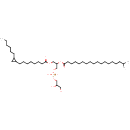|
Record Information |
|---|
| Version |
1.0 |
|---|
| Update Date |
1/22/2018 11:54:54 AM |
|---|
|
Metabolite ID | PAMDB004094 |
|---|
|
Identification |
|---|
| Name: |
PG(17:0cycw7c/19:iso) |
|---|
| Description: | PG(17:0cycw7c/19:iso) is a phosphatidylglycerol. Phosphatidylglycerols consist of a glycerol 3-phosphate backbone esterified to either saturated or unsaturated fatty acids on carbons 1 and 2. As is the case with diacylglycerols, phosphatidylglycerols can have many different combinations of fatty acids of varying lengths and saturation attached to the C-1 and C-2 positions. PG(17:0cycw7c/19:iso), in particular, consists of one heptadec-9-10-cyclo-anoyl chain to the C-1 atom, and one 17-methylocatdecanoyl to the C-2 atom. In Pseudomonas aeruginosa glycerophospholipid metabolism, phosphatidylglycerol is formed from phosphatidic acid (1,2-diacyl-sn-glycerol 3-phosphate) by a sequence of enzymatic reactions that proceeds via two intermediates, cytidine diphosphate diacylglycerol (CDP-diacylglycerol) and phosphatidylglycerophosphate (PGP, a phosphorylated phosphatidylglycerol). Phosphatidylglycerols, along with CDP-diacylglycerol, also serve as precursor molecules for the synthesis of cardiolipin, a phospholipid found in membranes. |
|---|
|
Structure |
|
|---|
| Synonyms: | - 1-heptadec-9-10-cyclo-anoyl-2-17-methylocatdecanoyl-sn-glycero-3-phospho-(1'-glycerol)
- 1-heptadec-9-10-cyclo-anoyl-2-17-methylocatdecanoyl-sn-glycero-3-phosphoglycerol
- 1-heptadec-9-10-cyclo-anoyl-2-17-methylocatdecanoyl-sn-glycero-3-phosphoglycerol
- GPG(17:0/19:0)
- GPG(36:0)
- PG(17:0/19:0)
- PG(36:0)
- Phosphatidylglycerol(17:0/19:0)
- Phosphatidylglycerol(36:0)
|
|---|
|
Chemical Formula: |
C42H81O10P |
|---|
| Average Molecular Weight: |
777.0603 |
|---|
| Monoisotopic Molecular
Weight: |
776.556735324 |
|---|
| InChI Key: |
QILGVRPJBLYQLH-UHFFFAOYSA-N |
|---|
| InChI: | InChI=1S/C42H81O10P/c1-4-5-6-22-27-37-31-38(37)28-23-18-16-20-24-29-41(45)49-34-40(35-51-53(47,48)50-33-39(44)32-43)52-42(46)30-25-19-15-13-11-9-7-8-10-12-14-17-21-26-36(2)3/h36-40,43-44H,4-35H2,1-3H3,(H,47,48) |
|---|
| CAS
number: |
Not Available |
|---|
| IUPAC Name: | (2,3-dihydroxypropoxy)(3-{[8-(2-hexylcyclopropyl)octanoyl]oxy}-2-[(17-methyloctadecanoyl)oxy]propoxy)phosphinic acid |
|---|
|
Traditional IUPAC Name: |
2,3-dihydroxypropoxy(3-{[8-(2-hexylcyclopropyl)octanoyl]oxy}-2-[(17-methyloctadecanoyl)oxy]propoxy)phosphinic acid |
|---|
| SMILES: | CCCCCCC1CC1CCCCCCCC(=O)OCC(COP(O)(=O)OCC(O)CO)OC(=O)CCCCCCCCCCCCCCCC(C)C |
|---|
|
Chemical Taxonomy |
|---|
|
Taxonomy Description | This compound belongs to the class of organic compounds known as phosphatidylglycerols. These are glycerophosphoglycerols in which two fatty acids are bonded to the 1-glycerol moiety through ester linkages. |
|---|
|
Kingdom |
Organic compounds |
|---|
| Super Class | Lipids and lipid-like molecules |
|---|
|
Class |
Glycerophospholipids |
|---|
| Sub Class | Glycerophosphoglycerols |
|---|
|
Direct Parent |
Phosphatidylglycerols |
|---|
| Alternative Parents |
|
|---|
| Substituents |
- 1,2-diacylglycerophosphoglycerol
- Fatty acid ester
- Dialkyl phosphate
- Dicarboxylic acid or derivatives
- Fatty acyl
- Alkyl phosphate
- Organic phosphate
- Organic phosphoric acid derivative
- Phosphoric acid ester
- 1,2-diol
- Carboxylic acid ester
- Secondary alcohol
- Carboxylic acid derivative
- Hydrocarbon derivative
- Organic oxide
- Alcohol
- Carbonyl group
- Primary alcohol
- Organooxygen compound
- Aliphatic homomonocyclic compound
|
|---|
| Molecular Framework |
Aliphatic homomonocyclic compounds |
|---|
| External Descriptors |
Not Available |
|---|
|
Physical Properties |
|---|
| State: |
Solid |
|---|
| Charge: | -1 |
|---|
|
Melting point: |
Not Available |
|---|
| Experimental Properties: |
|
|---|
| Predicted Properties |
|
|---|
|
Biological Properties |
|---|
| Cellular Locations: |
Membrane |
|---|
| Reactions: | |
|---|
|
Pathways: |
|
|---|
|
Spectra |
|---|
| Spectra: |
|
|---|
|
References |
|---|
| References: |
- Casadei MA, Ma?as P, Niven G, Needs E, Mackey BM. (2002) "Role of membrane fluidity in pressure resistance of Escherichia coli NCTC 8164." Appl Environ Microbiol. 68(12):5965-72. Pubmed: 12450817
- Kanehisa, M., Goto, S., Sato, Y., Furumichi, M., Tanabe, M. (2012). "KEGG for integration and interpretation of large-scale molecular data sets." Nucleic Acids Res 40:D109-D114. Pubmed: 22080510
- Yurtsever D. (2007). Fatty acid methyl ester profiling of Enterococcus and Esherichia coli for microbial source tracking. M.sc. Thesis. Villanova University: U.S.A
|
|---|
| Synthesis Reference: |
Not Available |
|---|
| Material Safety Data Sheet (MSDS) |
Not Available |
|---|
|
Links |
|---|
| External Links: |
| Resource | Link |
|---|
| CHEBI ID | Not Available | | HMDB ID | Not Available | | Pubchem Compound ID | Not Available | | Kegg ID | Not Available | | ChemSpider ID | Not Available | | Wikipedia ID | Not Available | | BioCyc ID | Not Available |
|
|---|


